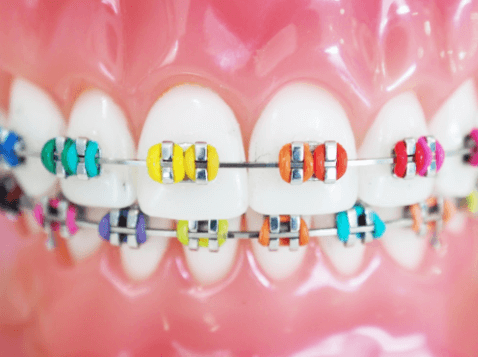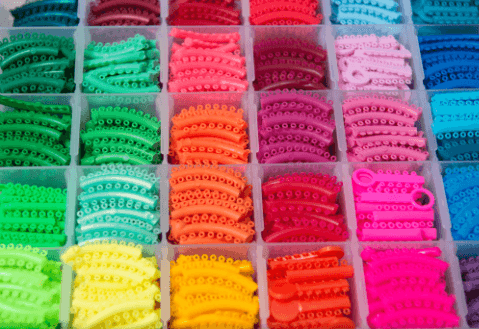
Dental Braces
The best way to align teeth that may appear wonky or asymmetrical is through the use of a dental brace. Although a lot of people may associate pain and discomfort with the thought of having braces, the end results are fantastic and make the entire process undoubtedly worthwhile. In modern-day society, more and more people are choosing to get braces despite their age or any other contributing factors.
Braces have become somewhat fashionable in recent years and the fact that they can be different colours is definitely a massive part of this trend.
The trend began in America, where it first started gaining popularity, but it is now common to see people with colourful braces around the whole world, including individuals with braces in the United Kingdom.
This trend has been fueled by the fact that whether you use private orthodontic treatment or that offered by the NHS, coloured braces are provided by both. This means that everyone can access coloured braces easily and can then accessorise them however they want.
What are coloured braces?
In order to align your teeth, dental braces can be attached to them. These braces are attached to your teeth through the use of small metal brackets, throughout all of your orthodontic treatment. Your teeth become straight when these brackets are moved by a thin wire, this wire is held into place by tiny elastic bands that are professionally known as ‘ligature.’
These little elastic bands can come in a variety of colours, everything from clear or white, to purple or orange, and are what make your braces appear coloured.
Most orthodontic practices will allow you to choose as many colours as you like and let you mix and match as much as possible.
Furthermore, these elastic bands are changed every time you visit your orthodontist – which is usually every six to eight weeks – meaning you will be able to try out a few new looks, meaning that nothing is permanent and you can experiment with your braces as much as you’d like
However, unfortunately for those attending NHS appointments, there usually is not enough time to pick more than two colours, but it’s always worth speaking to your clinician to see if this isn’t the case on the day.
You will still be able to have coloured braces and change them at every appointment, you just might not be able to have more than two colours in your braces at the same time.
Choosing Your Perfect Colour
There are a few things that must be considered before making your decision of which colour braces to go with, think about the tone of your skin, as some colours are likely to suit different tones better than others would.

Take your teeth into consideration as well, different colours may complement your pearly whites in different ways, some braces may make your teeth look brighter, whereas other colours might do the opposite. Finally, it is good to remember that some braces could potentially be stained by foods more than others.
For people who naturally have a lighter skin tone, we would recommend opting for colours like light blue, soft reds, dark purple and finally bronze, as these will complement your light skin the most, and make your face seem a lot brighter.
If you have a medium skin tone, we may suggest choosing warmer greens and blues along with subtle oranges and pinks, for your braces. As your skin probably has undertones of yellow, olive, and peach, these colours will compliment you best and make your skin look warm and bright.
If you have a naturally darker skin tone, we think you should choose golds, dark blues, pinks, oranges, and even turquoise, greens, and violets as these colours of braces will best complement your darker tones.
Finally, to make your teeth appear whiter, we recommend staying away from clear bands on your braces, as they can stain easily and show every leftover piece of food. It’s also not a good idea to choose white, as they can clash with your teeth and make your smile appear yellowish.
Instead, we suggest mixing both light and dark colours to create a contrast of coloured braces, which will in turn make your smile appear brighter and your teeth whiter.
Colours To Avoid
Although there are many great brace colours to compliment your teeth and skin tones, there are also some colours that you may wish to avoid as they can make your smile appear different than it really is. Black braces can make your teeth appear as though they are rotting and even make it look like there is leftover food stuck in your teeth.
Furthermore, yellow braces can intensify the appearance of yellow-toned teeth, and green or brown may again be mistaken for more food in your teeth, so think twice before colouring your braces this way.
Mix and Match Your Braces
If you are one of those people who loves to stand out and try something a little different, then you should really consider mixing and matching the colours of your braces. Why not try out some pastel colours for a very on-trend vibe or black and white bands for an edgy look.
In addition to this, you may want to match your braces with your favourite colour, or even with the time of the year. For example, why not go for some festive reds and greens for the Christmas season, or even some glow-in-the-dark ones for Halloween.
Caring For Your Coloured Braces
Oral hygiene is essential for maintaining a healthy smile, and while wearing braces this is even more so. If your braces are not cleaned regularly then they can become a breeding ground for bacteria and can result in tooth decay.
To combat this, we recommend brushing and flossing at least twice a day, and if possible after every meal. When it comes to brushing with braces, it is advised to invest in an electric toothbrush or other orthodontic cleaning equipment, as they will be more effective and will reach all those hard-to-get areas.
For more information on how to properly care for your teeth, why not take a look at our guide to removing plaque and tartar.
